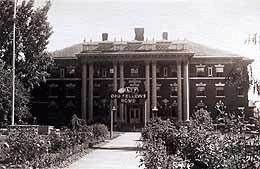In July 1942, the USO (United Service Organizations) opens in Walla Walla's business district at 110 W Alder Street. In the context of World War II, Walla Walla had organized to create a recreation center to serve the enlisted men and women arriving at a nearby army airfield established in March 1942. The Veterans of Foreign Wars (VFW) had made their clubhouse available on June 1. 1942. A month later the USO opens its clubhouse.
Civilians and Soldiers During Wartime
The United Service Organizations (USO), a national organization, was incorporated on February 4, 1941. It was made up of six agencies: YMCA, YWCA, Salvation Army, Jewish Welfare Bureau, National Catholic Community Services, and Travelers Aid. Early in the war, the agencies had joined together under the name, United Welfare Committee for Defense. The committee sent President Franklin D. Roosevelt (1882-1945) a telegram requesting a meeting with government officials to present its views. In December the committee met with Paul V. McNutt (1891-1955), head of the Federal Security Agency, whose responsibilities included recreation. Roosevelt in turn directed the Federal Security Agency to work with the welfare committee to come up with an effective program.
President Roosevelt, recognizing the interest of citizen-soldiers in seeking civilian recreation, believed that community-based programs could best satisfy this reality. Additionally, providing community recreation centers would reduce the perceived threat of large number of military personnel hanging out with nothing to do. Another advantage would be to enlist local civilian populations, especially women, in the war effort, giving them meaningful functions. The USO was in the position to hire professional staff, and this gave it a tremendous advantage in providing an effective recreational and morale-building organization for service men and women far from home during wartime.
Walla Walla's USO
In Walla Walla the USO club was established in a former store. The club was equipped with a small library, writing tables, "Talk a Letter Home" voice records, and billiards. On the second floor was an archery range. The USO offered free refreshments and its snack bar sold reasonably priced homemade baked beans. Occasionally the Walla Walla All City Choir performed at the club. Soldiers wanting to go skiing could borrow the equipment and ski free at Tollgate Ski area.
On Monday evenings Bobby McInroe played the piano while the GIs sang. Tuesdays featured bridge and rummy with girl partners. On Wednesdays the soldiers took part in large group-singing or some worked in the darkroom. The main events on Thursday nights were party games with the junior hostesses participating and refreshments. Friday nights the junior hostesses dressed up for USO dances at local halls, such as the Odd Fellows Temple. Movies were the Saturday feature. Musical entertainment and a movie made Sunday evenings enjoyable.
The USO staff discovered that many soldiers did not know how to dance so clubs gave lessons. Lucy Ransom started dance lessons on Thursday nights in 1943 and they became very popular.
Comfort in Hard Times
Each year the USO welcomed about 200,000 guests. This club and others made adjustments as the war went on. They added programs in military hospitals as the wounded returned to the United States.
In March 1943 a 1,500-bed army hospital, McCaw General Hospital, opened at Walla Walla. The USO frequently visited and entertained in the hospital wards. The USO club in town counted 205,000 visitors in 1945 and then decreased attendance in early 1946 and closed in May that year.
Walla Walla had an African American USO on West Main Street with a schedule similar to the larger club. Fortunately, this unit remained open after most other small USOs in the Pacific Northwest had closed.

